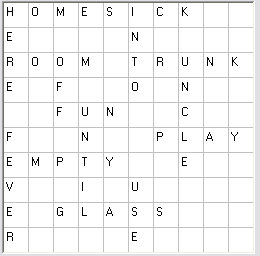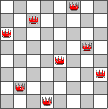What's New - April 2003
[Home]
 April 29, 2003: Finally, a new
program! Not that all the fixups this month weren't needed,
but sooner or later one needs something new to exercise
the "design-side" brain lobes. Crossword Generator V0.0
solves the problem of placing a set of intersecting words on a
crossword puzzle board. Only a half dozen steps away
from a complete generator program.
April 29, 2003: Finally, a new
program! Not that all the fixups this month weren't needed,
but sooner or later one needs something new to exercise
the "design-side" brain lobes. Crossword Generator V0.0
solves the problem of placing a set of intersecting words on a
crossword puzzle board. Only a half dozen steps away
from a complete generator program.
 April 25, 2003: A couple of years ago I wrote
and posted Fibonacci
Sunflowers, which draws primitive sunflowers showing the
"double spiral effect" if seeds are spaced by an
angle approximating the ratio of two consecutive Fibonacci
numbers. A sharp eyed viewer just discovered that one
example separated seeds by 31/55 radians instead of 34/55
radians. It's now fixed. If you haven't had a chance
to investigate Fibonacci numbers and their relationship to the
"Golden Ratio", here's a small start.
April 25, 2003: A couple of years ago I wrote
and posted Fibonacci
Sunflowers, which draws primitive sunflowers showing the
"double spiral effect" if seeds are spaced by an
angle approximating the ratio of two consecutive Fibonacci
numbers. A sharp eyed viewer just discovered that one
example separated seeds by 31/55 radians instead of 34/55
radians. It's now fixed. If you haven't had a chance
to investigate Fibonacci numbers and their relationship to the
"Golden Ratio", here's a small start.
 April 16,
2003: A month ago we published the 10X10 version of the
Token Flip Puzzle even though no one I knew (at the time) could
solve it. I also requested help in finding an solution
algorithm so I could stop worrying on it. Viewer Bernd
Hellema came through with a linear programming solution that
solves any practical size in milliseconds! Personally,
I wouldn't know a Gaussian Elimination from a hole-in-the-ground,
but Bernd does. Check out Token Flip - the Final Chapter!.
April 16,
2003: A month ago we published the 10X10 version of the
Token Flip Puzzle even though no one I knew (at the time) could
solve it. I also requested help in finding an solution
algorithm so I could stop worrying on it. Viewer Bernd
Hellema came through with a linear programming solution that
solves any practical size in milliseconds! Personally,
I wouldn't know a Gaussian Elimination from a hole-in-the-ground,
but Bernd does. Check out Token Flip - the Final Chapter!.
Also, in case your great emails don't get
answered right away, we're off on vacation to visit grandkids over
Easter. See you in a week or so.
 April 8, 2003: About a year
ago I posted Eight Queens Wirth, a program which uses
Niklaus Wirth's clever algorithm to solve the "Eight
Queens" problem - place 8 chess queens on a standard 8x8
chessboard in such a way that no queen threatened
another. The program actually resides as an addendum
to the Eight Queens Plus
program page, an extension of the problem that requires that the
main diagonals remain unoccupied.
April 8, 2003: About a year
ago I posted Eight Queens Wirth, a program which uses
Niklaus Wirth's clever algorithm to solve the "Eight
Queens" problem - place 8 chess queens on a standard 8x8
chessboard in such a way that no queen threatened
another. The program actually resides as an addendum
to the Eight Queens Plus
program page, an extension of the problem that requires that the
main diagonals remain unoccupied.
Eight Queens Wirth finds all 92 solutions and also finds the largest set of solutions that can co-exist on the board without overlapping any other solution (6 solutions). Recently a viewer asked about the smallest set of solutions that could cover all squares of the board. I posted a new version today that tries to answer that question as well. My answer finds 12 solutions that cover the board, I suspect that this is the smallest set. But I haven't proved that it could not be done with 9, 10 or 11 solutions. If anyone has any more information about a definitive answer to this question, please let me know.
April 6, 2003: I recently upgraded to Delphi 7. One of the advantages of being a substitute teacher at our local high school is access to academic software. I couldn't pass up acquiring D7 Professional for $99! However, there are some downward compatibilities between D7 and D5 (or earlier, I presume) even if no D7 enhancements are used. I have been trying to make sure that postings here will compile under D5, but missed checking yesterday's Wordstuff 2. Bottom line, if you downloaded the program yesterday, and it does not compile successfully, try downloading again.
April 5, 2003: One of my kids bought me "The Code Book" (Simon Singh, Anchor Books) for my birthday last month. It's an excellent history of cryptography - very readable with fascinating codemaking/codebreaking stories from Egyptian hieroglyphics and ancient Roman times through current "Public Key" and "Pretty Good Privacy" cryptography techniques. There are enough examples along the way to make you feel that you might even understand some of it.
As a result, I worked this week on the decryption program, Decrypt, and incorporated the revised version into Word Stuff 2. It's better than the original, but still leaves lots of room for improvement. I did add the ability for users to make suggestions to the program to speed it along its decipherment path. Fully automated decryption in the general case, even for simple mono-alphabetic encryptions, is still far from reality. Working on the problem does make you appreciate the achievements of all those high IQ codemakers and codebreakers.
